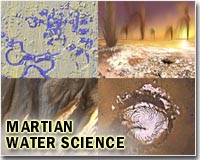 |
Pasadena CA (JPL) Apr 25, 2011 NASA's Mars Reconnaissance Orbiter has discovered the total amount of atmosphere on Mars changes dramatically as the tilt of the planet's axis varies. This process can affect the stability of liquid water, if it exists on the Martian surface, and increase the frequency and severity of Martian dust storms. Researchers using the orbiter's ground-penetrating radar identified a large, buried deposit of frozen carbon dioxide, or dry ice, at the Red Planet's south pole. The scientists suspect that much of this carbon dioxide enters the planet's atmosphere and swells the atmosphere's mass when Mars' tilt increases. The findings are published in this week's issue of the journal Science. The newly found deposit has a volume similar to Lake Superior's nearly 3,000 cubic miles (about 12,000 cubic kilometers). The deposit holds up to 80 percent as much carbon dioxide as today's Martian atmosphere. Collapse pits caused by dry ice sublimation and other clues suggest the deposit is in a dissipating phase, adding gas to the atmosphere each year. Mars' atmosphere is about 95 percent carbon dioxide, in contrast to Earth's much thicker atmosphere, which is less than .04 percent carbon dioxide. "We already knew there is a small perennial cap of carbon-dioxide ice on top of the water ice there, but this buried deposit has about 30 times more dry ice than previously estimated," said Roger Phillips of Southwest Research Institute in Boulder, Colo. Phillips is deputy team leader for the Mars Reconnaissance Orbiter's Shallow Radar instrument and lead author of the report. "We identified the deposit as dry ice by determining the radar signature fit the radio-wave transmission characteristics of frozen carbon dioxide far better than the characteristics of frozen water," said Roberto Seu of Sapienza University of Rome, team leader for the Shallow Radar and a co-author of the new report. Additional evidence came from correlating the deposit to visible sublimation features typical of dry ice. "When you include this buried deposit, Martian carbon dioxide right now is roughly half frozen and half in the atmosphere, but at other times it can be nearly all frozen or nearly all in the atmosphere," Phillips said. An occasional increase in the atmosphere would strengthen winds, lofting more dust and leading to more frequent and more intense dust storms. Another result is an expanded area on the planet's surface where liquid water could persist without boiling. Modeling based on known variation in the tilt of Mars' axis suggests several-fold changes in the total mass of the planet's atmosphere can happen on time frames of 100,000 years or less. The changes in atmospheric density caused by the carbon-dioxide increase also would amplify some effects of the changes caused by the tilt. Researchers plugged the mass of the buried carbon-dioxide deposit into climate models for the period when Mars' tilt and orbital properties maximize the amount of summer sunshine hitting the south pole. They found at such times, global, year-round average air pressure is approximately 75 percent greater than the current level. "A tilted Mars with a thicker carbon-dioxide atmosphere causes a greenhouse effect that tries to warm the Martian surface, while thicker and longer-lived polar ice caps try to cool it," said co-author Robert Haberle, a planetary scientist at NASA's Ames Research Center in Moffett Field, Calif. "Our simulations show the polar caps cool more than the greenhouse warms. Unlike Earth, which has a thick, moist atmosphere that produces a strong greenhouse effect, Mars' atmosphere is too thin and dry to produce as strong a greenhouse effect as Earth's, even when you double its carbon-dioxide content." The Shallow Radar, one of the Mars Reconnaissance Orbiter's six instruments, was provided by the Italian Space Agency, and its operations are led by the Department of Information Engineering, Electronics and Telecommunications at Sapienza University of Rome.
Share This Article With Planet Earth
Related Links Mars Reconnaissance Orbiter Mars News and Information at MarsDaily.com Lunar Dreams and more
 Dry ice find hints Mars was a wetter place: study
Dry ice find hints Mars was a wetter place: studyWashington (AFP) April 21, 2011 NASA has discovered that the south pole of Mars is home to 30 times more dry ice than previously believed, suggesting that the red planet was once a much wetter place, said a study on Thursday. Taking data from the Mars Reconnaissance Orbiter, researchers found "large quantities of ancient atmospheric carbon dioxide may be trapped in the solid chunks of dry ice," said the study published in ... read more |
|
| The content herein, unless otherwise known to be public domain, are Copyright 1995-2010 - SpaceDaily. AFP and UPI Wire Stories are copyright Agence France-Presse and United Press International. ESA Portal Reports are copyright European Space Agency. All NASA sourced material is public domain. Additional copyrights may apply in whole or part to other bona fide parties. Advertising does not imply endorsement,agreement or approval of any opinions, statements or information provided by SpaceDaily on any Web page published or hosted by SpaceDaily. Privacy Statement |